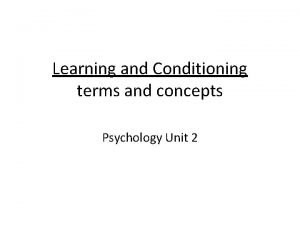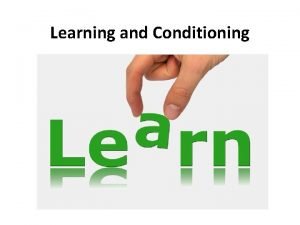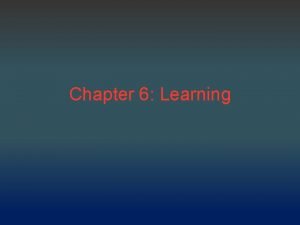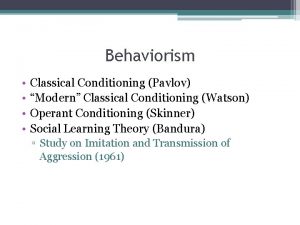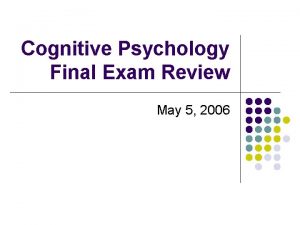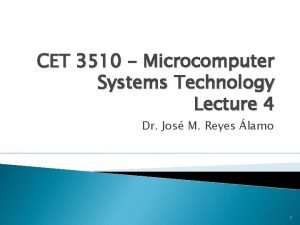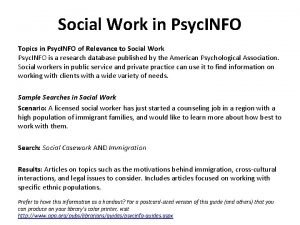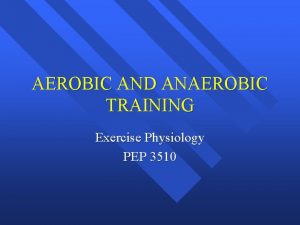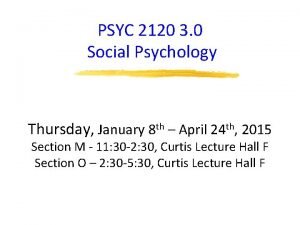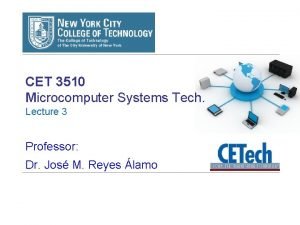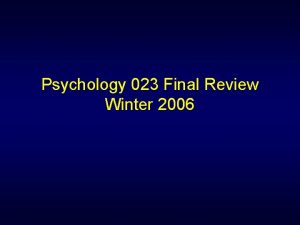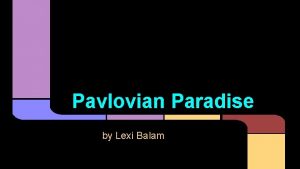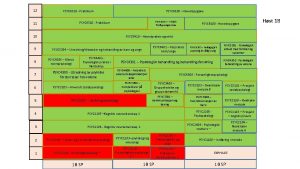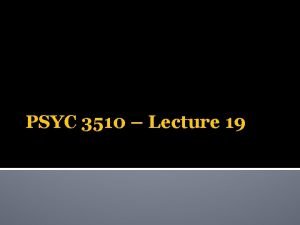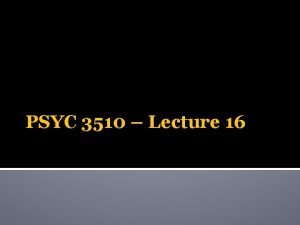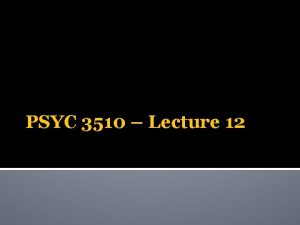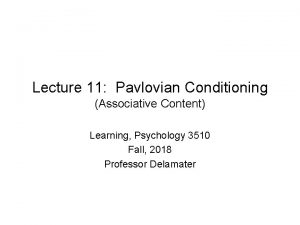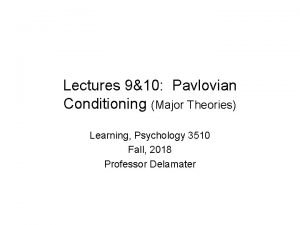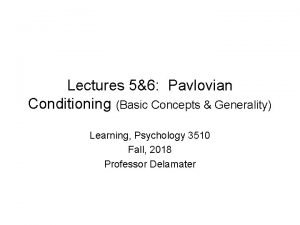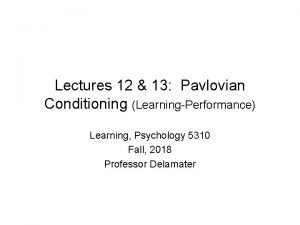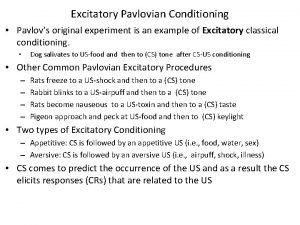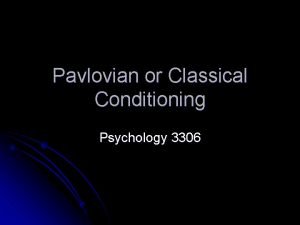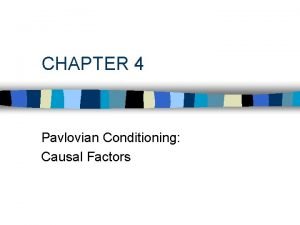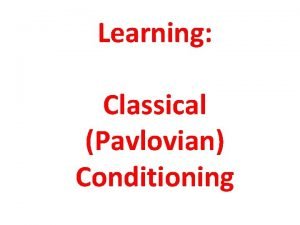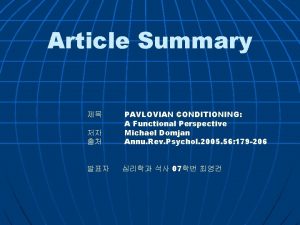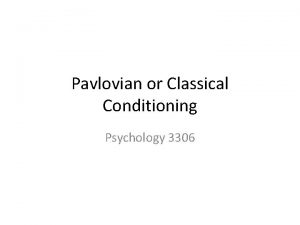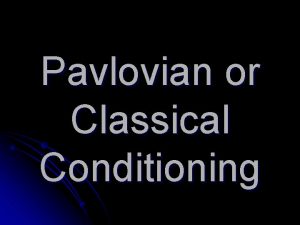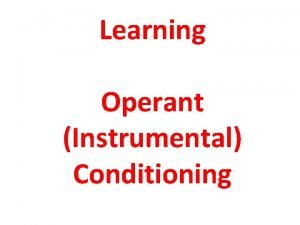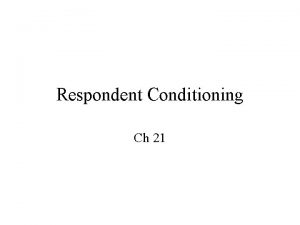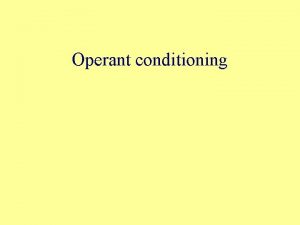PSYC 3510 Lecture 4 Pavlovian Conditioning Procedures Components
























- Slides: 24

PSYC 3510 – Lecture 4

Pavlovian Conditioning Procedures � Components of a Pavlovian experiment: Sessions Blocks Trials conditioning

Pavlovian Conditioning Procedures One trial

Pavlovian Conditioning Procedures A block of four trials

Pavlovian Conditioning Procedures A session of three blocks

Pavlovian Conditioning Procedures

Pavlovian Conditioning Procedures

Pavlovian Conditioning Procedures

Pavlovian Conditioning Procedures CS-US interval

Pavlovian Conditioning Procedures Inter-trial interval (ITI)

Pavlovian Conditioning Procedures

Pavlovian Conditioning Procedures � Measuring the conditioned response (during a ‘test trial’) - Magnitude vs.

Pavlovian Conditioning Procedures � Measuring the conditioned response (during a ‘test trial’) - Magnitude - Frequency Trial 1 Trial 2 Trial 3

Pavlovian Conditioning Procedures � Measuring the conditioned response (during a ‘test trial’) - Magnitude - Frequency - Latency 0 s 0. 1 s 0. 2 s 0. 3 s

Pavlovian Conditioning Procedures � How do we really know if a CS-US association exists?

Pavlovian Conditioning Procedures � How do we really know if a CS-US association exists? � “Unpaired” control group

Pavlovian Conditioning Procedures CS presented at random times throughout session. No shocks are given.

Inhibitory Conditioning � Excitatory conditioning involves predicting the US from a CS. � Inhibitory conditioning involves predicting the absence of the US from a CS.

Inhibitory Conditioning � Pavlov’s procedure for conditioned inhibition. A+ AB- US nothing

Inhibitory Conditioning � Measuring conditioned inhibition

Inhibitory Conditioning � Measuring conditioned inhibition - Summation test

Inhibitory Conditioning � Measuring conditioned inhibition - Summation test Acquisition A+ US B+ US AX- Test BX- nothing If responding to BX- is lower than B+ from the outset of the test phase, then X- is said to be a conditioned inhibitor.

Inhibitory Conditioning � Measuring conditioned inhibition - Retardation of acquisition test

Inhibitory Conditioning � Measuring conditioned inhibition - Retardation of acquisition test Acquisition A+ US B+ US AX- Test X+ US Y+ US nothing If X developed conditioned inhibition during the acquisition phase, then it should take longer to acquire responding to X than Y during the test phase.
 Classical conditioning
Classical conditioning Pavlovian conditioning
Pavlovian conditioning Watson behaviorism theory
Watson behaviorism theory Generalization psychology
Generalization psychology Examples of negative reinforcement in the classroom
Examples of negative reinforcement in the classroom Operant conditioning classical conditioning
Operant conditioning classical conditioning Operant vs classical
Operant vs classical Fixed-ratio schedule example
Fixed-ratio schedule example A very bright mildly painful light
A very bright mildly painful light Classical conditioning vs operant conditioning
Classical conditioning vs operant conditioning Skinner's schedules of reinforcement
Skinner's schedules of reinforcement Operant conditioning
Operant conditioning Classical conditioning vs operant conditioning
Classical conditioning vs operant conditioning 01:640:244 lecture notes - lecture 15: plat, idah, farad
01:640:244 lecture notes - lecture 15: plat, idah, farad Psyc 1504 final exam
Psyc 1504 final exam Cet 3510
Cet 3510 Psyc 311 study guide
Psyc 311 study guide Psyc info
Psyc info Pep 3510a
Pep 3510a Psyc 2120
Psyc 2120 Telecharger formulaire cerfa 60-3510
Telecharger formulaire cerfa 60-3510 Used pep 3510
Used pep 3510 Psyc info
Psyc info Sfu tableau access
Sfu tableau access Psyc 1504 final exam
Psyc 1504 final exam
